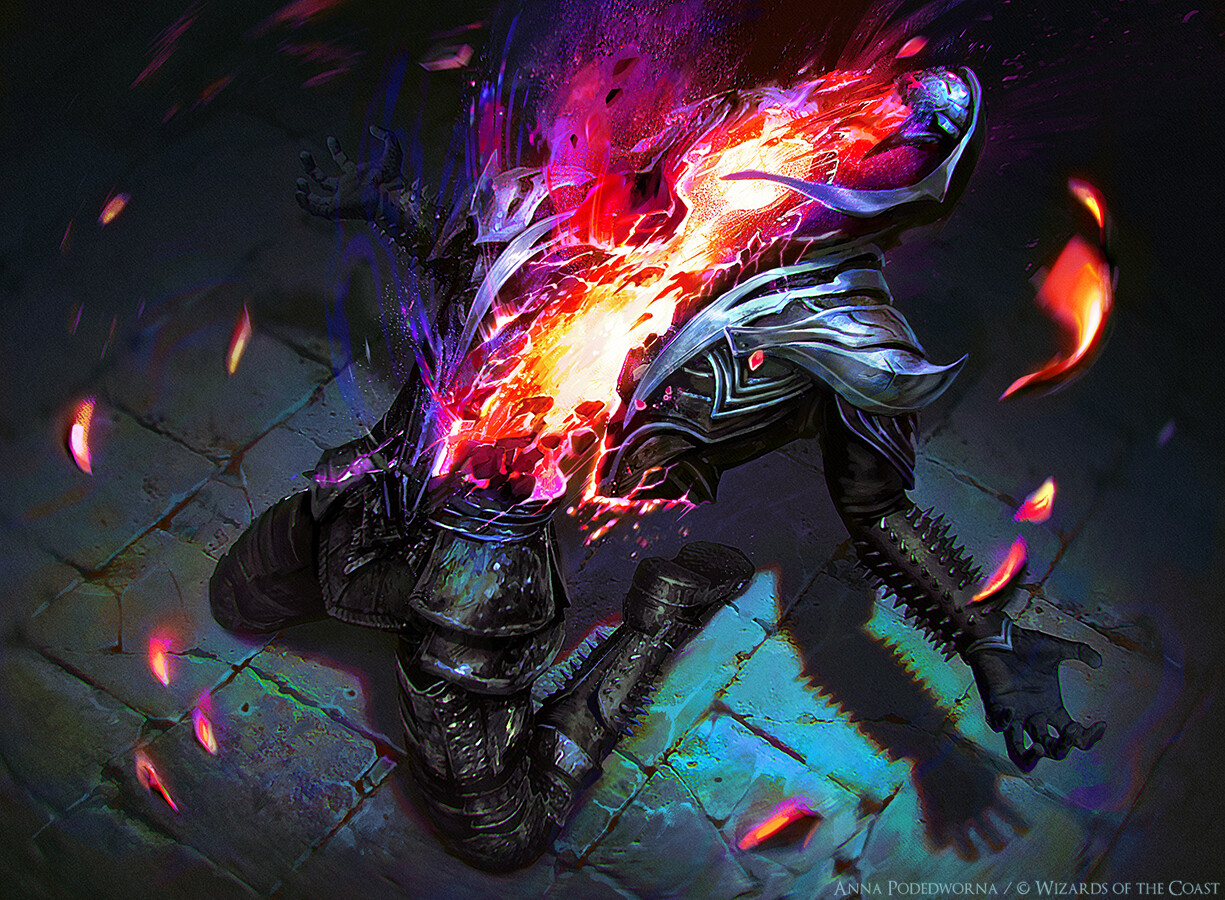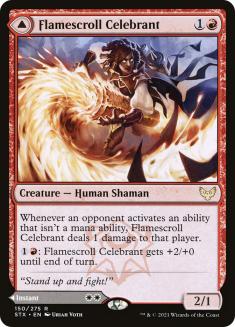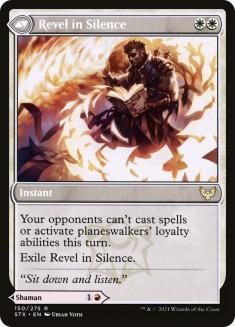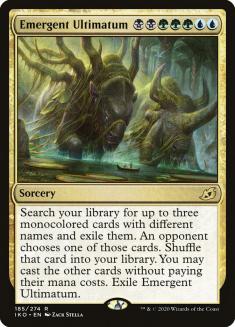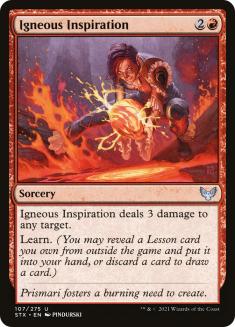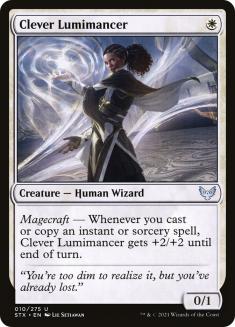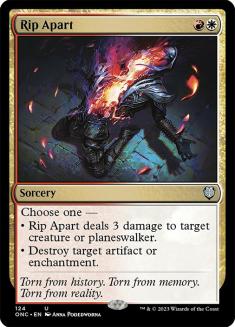Aggro decks often contain creatures with powerful static abilities. Those creatures double up on utility by providing the wielder with a body to pressure the life total as well as an extra ability (or two) that bottlenecks your opponent in some way. White is best-known for doing this type of thing, using the colloquial term “hatebear,” as many of the creatures tend to have two power and specifically “hate” on a specific archetype or strategy. On occasion, we find all-stars that span multiple formats and shape entire ecosystems. If you’ve ever played against Thalia, Guardian of Thraben, you’ll know exactly what I’m talking about.
Creatures like that tend to have staying power because they’re banking on the rest of your deck being full of good cards. Or, at the very least, they revolve around putting two or three of them onto the battlefield to create some soft lock. Every once in a while, a creature’s ability will far outshine the body. At other times, the body is the more important aspect, with the effect it provides being more of a bonus. I can’t think of too many cards in Magic’s history where I would value the body and ability on equal footing.
Flamescroll Celebrant might be in a class of its own.
A two-power creature for two mana with a boatload of abilities, Flamescroll Celebrant offers the caster a wide range of protective elements, pressure through both attacking and its triggered ability, Firebreathing, and a back half that offers a nice blanket against Storm and Storm-adjacent strategies. Since Flamescroll Celebrant is the half most likely to be cast, let’s talk about that one first.
Firedrinker Satyr was one of the cooler creatures in Boss Red when it was in Standard. Not only was it a virtual Jackal Pup, it gave you a way to use extra mana to deal extra damage. It was far above the curve in terms of playability, and one of the better aggro one-drops I’ve had the pleasure of casting. Flamescroll Celebrant is not Firedrinker Satyr. Two mana is significantly more than one, so the effect needs to be top-notch for the increase in rate. What we’re getting for the mana should cover it nicely.
Firebreathing is usually reserved for cards that need a little bit of a kick or have some gimmick ability like double strike. Pumping those creatures is often a hassle because the body itself doesn’t start as much. Usually you’re paying three mana for a two-power creature or similar, and the Firebreathing effect is about two mana per one extra damage on average. It’s rare that we get the one-for-one mana-to-damage ratio, but that’s exactly what’s being offered on this little menace.
The static effect that punishes opponents for activating abilities will come up quite often in older formats. Fetchlands are the obvious bit, but there are many different activated abilities that you just don’t think about from match to match. Every tapping of that cool artifact or use of a planeswalker leaves a damage behind. Hell, even cycling is technically an activated ability, which should amount to a lot of free burn against any of those weirdos playing Zenith Flare in Standard.
In many respects, Flamescroll Celebrant reminds me of Tunnel Ignus. When it was first printed, Primeval Titan was in Standard, which meant red aggro decks had a two-drop that dealt some free damage to opponents who were ramping. In reality, Titan players would just use their Lightning Bolt to dumpster it before casting any other spells, but the threat of it was often just as important as the card itself.
It’s one of those creatures where you don’t get to see how good it is because your opponent just can’t cast some of their spells or else they’re taking surprise lethal on the next turn. It’s terrifying. However, the low damage output for the mana cost was a significant drawback. Luckily, Flamescroll Celebrant has about four paragraphs more text where it offers a much stronger body, as well as more versatile gameplay.
Revel in Silence is effectively just Silence in about all the ways that really matter. In Strixhaven Standard, Revel in Silence will most often be cast in response to Emergent Ultimatum, effectively countering it in an archetype that doesn’t usually have a way out against a big spell like that. Most of the time, your way to fight big spells like that is by closing the game before they hit seven mana. When the ramp decks are interacting and sweeping every turn, that becomes a bit harder to do. Revel in Silence is the perfect foil for when the game is going exactly in the opposite direction of where you want it to, stifling the payoff for one of the best decks in Strixhaven Standard.
With that said, Revel in Silence won’t likely be what you’re casting in Strixhaven Standard. Your goal should be to curve out, using Flamescroll Celebrant as an early threat that allows you to spend excess mana for damage rather than committing new threats to the battlefield. While that can leave you open to spot removal to take the wind out of your sails, figuring out when to activate and when to play more aggressively will depend on the variables in each situation.
Flamescroll Celebrant is such a powerful two-drop threat because it lets you hold resources while applying pressure at about the normal clip of mana-spent-to-damage ratio. Smashing in for five damage on the third turn and pressing down on their activated ability use is sweet, as squeezing your opponent from two angles is exactly what you want your creatures to do.
Eidolon of the Great Revel comes to mind when thinking about Flamescroll Celebrant, if only because they both cost two mana, are red, and offer you a punisher effect. Where Eidolon of the Great Revel shines on the ability side of things, dealing massive amounts of damage to any opponent spinning their wheels or not interacting, Flamescroll Celebrant offers a more robust suite of decisions. It plays like a traditional aggressive creature with a cool ability rather than being a husk that just carries around a desirable effect. Eidolon of the Great Revel is the picture-perfect “hatebear,” where Flamescroll Celebrant is more akin to “good creature plus” which is likely more valuable in the current Standard format.
Here is where I’ll be starting with Flamescroll Celebrant in Strixhaven Standard to see if the front half is good enough to play on its own.
Creatures (23)
- 4 Robber of the Rich
- 4 Fervent Champion
- 4 Bonecrusher Giant
- 3 Torbran, Thane of Red Fell
- 4 Anax, Hardened in the Forge
- 4 Flamescroll Celebrant
Lands (24)
Spells (13)

The Embercleave deck hasn’t changed much in a while. It still casts a bunch of small creatures and still uses Embercleave to clean up after they’ve dealt a little bit of damage. My personal experience has me doubting Fireblade Charger, and Rimrock Knight just feels like it’s a 3/1 more often than gaining any marketable value from the Adventure side. I’m hoping Flamescroll Celebrant is a better two-drop, offering unique play patterns that help you spend more mana than your opponent in places where you don’t want to over-extend into a sweeper.
Having both Robber of the Rich and Flamescroll Celebrant in the two-drop slot makes me happy, as Robber of the Rich has overperformed time and time again. While Rimrock Knight was fine, and might deserve space in the deck given a different build, I want to see just how much of a difference Flamescroll Celebrant changes the early turns. How much damage will the ability do on average? Does it alter the opponent’s play? How often will I choose to do extra damage instead of casting Anax, Hardened in the Forge? All these questions matter, but none are as important as, “How good is the learn mechanic?”
A three-mana sorcery that deals three damage and allows you to rummage is pretty solid. Igneous Inspiration is way better than that, and its strength will solely depend on how good the Lesson cards are. At the moment, the only one I see that could fit into this deck is Spirit Summoning. A spell that draws another spell is pretty cool, as it effectively acts like “draw a card” but with conditions. In aggro, drawing an extra card might be worse than drawing Spirit Summoning. While it isn’t exactly stellar in and of itself, you gotta remember that it’s free. Free spells won’t be overwhelming. That’s kind of the whole point.
As we get more Lesson cards released, we’ll see just how good these learn cards can be. The current build is mostly just a placeholder to show you how stuff works, and creates space that we can come back to at a later time for tweaking numbers or shifting spells around. Lessons will likely lead the deck down the path toward more instants and sorceries, perhaps moving back toward a more traditional “Burn” style. However, Embercleave currently rewards you for putting permanents onto the battlefield, so casting spells that don’t add to that growing army will make Embercleave worse. Two battling principles, so perhaps we’ll need to re-evaluate closer to the set’s release.
An Introduction to Lorehold in Pioneer
I’m very excited to try Flamescroll Celebrant in Pioneer, a format that desperately wants a good two-drop and a way to hose Lotus Field Combo. Here is where I think Revel in Silence will start to shine, as Flamescroll Celebrant hits right on par with the power level and Revel in Silence actually does some work when you consider the players in the format.
One of my biggest theory stress points in Pioneer is that using all your mana every turn is important. Utility lands like Mutavault are perfect for doing exactly that, but ultimately lead you down the path of one-color aggro in order to offset the damage done by playing a land that taps for colorless. We can’t rightly play Mutavault in a deck featuring Rip Apart!
Because of that, it’s imperative that we create a tight one-color deck with Mutavault and Flamescroll Celebrant or go hard on Boros so we can consistently use Revel in Silence. Let’s take a look at both!
Creatures (21)
- 4 Monastery Swiftspear
- 4 Soul-Scar Mage
- 4 Rampaging Ferocidon
- 4 Bonecrusher Giant
- 1 Torbran, Thane of Red Fell
- 4 Flamescroll Celebrant
Planeswalkers (3)
Lands (24)
Spells (12)
Sideboard

This iteration puts the “punisher” mechanic on full display, while also maintaining a wide variety of mana sinks to translate mana to damage over time. Cards like Bonecrusher Giant are all-stars, but the devil really is in the details. This archetype edges toward the traditional Burn archetype but doesn’t quite move all in. That’s because you don’t have to. The Pioneer format is much more about on-battlefield presence and leveraging early threats by clearing blockers. Light Up the Stage in tandem with your Prowess creatures can lead to some incredible starts!
Here we’re only seeing the front half of Flamescroll Celebrant, but it might be good enough without the back half to see play in Pioneer. That’s how good I think this card is! However, I do want to showcase Revel in Silence a little bit, as I feel like I haven’t given it the attention it deserves.
Creatures (20)
Lands (21)
Spells (19)
Sideboard

This iteration of Lorehold in Pioneer showcases how seamlessly the new cards integrate into the already-existing “Burn” strategy. Flamescroll Celebrant is a big part of that, but we’ve talked enough about that particular two-drop. Let’s focus on the other new additions and see what white really brings to the table.
There’s been a lot of talk about Clever Lumimancer in Modern, and rightly so. Spells like Manamorphose turn this into a significant threat, acting like the Prowess deck’s Steppe Lynx. Without a little help, it doesn’t do much damage, but the upside is that it’s incredible when you’re functioning on all cylinders.
There is also some “risk” when it comes to adding a color to your deck, but it seems like we’ve reached critical mass for Pioneer with the addition of Needleverge Pathway. We have twenty lands that enter the battlefield untapped in the first few turns and can tap for either white or red. That means we can play one-drops of both colors without fear. Normally that is the breaking point for a second color in an aggro deck, as playing two different one-drops of differing colors often leads to wildly inconsistent draws, but that’s not a problem anymore.
Clever Lumimancer won’t be revolutionary, but I do think it’ll complement the rest of the archetype quite well. We’re blitzing on damage, trying to throw as much at our opponent as we can and dealing as much damage as we can in short bursts. Clever Lumimancer tags along nicely with our Prowess friends!
Another sweet addition to the archetype, Rip Apart gives us some outs to some really weird permanents. In older formats, I’m a huge fan of cards like this one. Abrade has seen play in numerous red decks, but Rip Apart could be the glue that keeps holding me to Lorehold. I love everything about it, even if it is operating at slug speed.
It’s versatile, which has inherent value. It’s efficient at what it does, and we’ve already discussed how little trouble we have finding white mana. I see little reason to skip on Rip Apart other than “there aren’t enough targets.” If that ends up being the case, I don’t know that I’ll be wanting to play too much Pioneer, because we’ll be living in a world where nonland permanents don’t really exist.
Final Thoughts
I believe there to be a good chance that Flamescroll Celebrant sees play in virtually every format thanks to Revel in Silence. Those types of “Silence” spells tend to be rather weak as maindeck cards but powerful and narrow as sideboard cards. I think Flamescroll Celebrant is strong enough to carry this card into playability in virtually every format where the storm mechanic exists, while giving red decks a tool to beat down with little consequence.
This card is all upside. I’m salivating at the thought of getting a playset because I know it’ll be in my Red Box for a long time to come. It is rare that we get a multi-card where one half is just good enough to see play all on its own. When that happens, we tend to forget about the weaker half, as that side doesn’t come up too often. I think what we’ll see with Flamescroll Celebrant is that weaker formats use it to attack, while more powerful formats use it as both a beatdown element and protective spell in case the worst happens. I’m here for both.
Will this card replace Eidolon of the Great Revel in Modern Burn? Almost certainly not. Will it be a valuable tool in multiple Lorehold decks now and into the future? Almost assuredly. Both halves are desirable in their own ways, and any deck that gets to play both is essentially freerolling with the other half, because both sides are stellar. I’m very much looking forward to seeing my opponent’s face turn to sour milk when I cast Revel in Silence with an advantageous battlefield, or when they cast Past in Flames, or maybe when they crack Lion’s Eye Diamond into Infernal Tutor. It’s all so juicy it’s making my mouth water.
I hope Lorehold finds some roots in Standard. The cards themselves that we’ve seen so far represent a different time in Magic’s history. It feels like so many of their tools just play fair, which can make for a fun Limited environment without putting Standard into a two-month coma while they scramble for bans. I’m loving this new direction for red and white, and can’t wait to see more. There’s just so much to discover!

